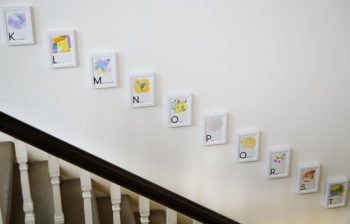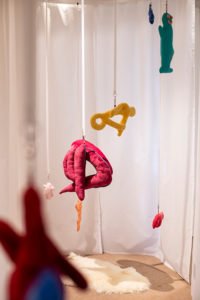Emma Smith’s exhibition, Wunderblock, is on until 26 May 2019.
In this post, curator Rachel Fleming-Mulford gives the inside track on the research behind it, and what to expect from a visit.
1. Wunderblock draws on intriguing historical research into the fascination with children’s minds during the Cold War.
“In this exhibition, Emma Smith uncovers and imagines the complexity of the child’s mind.”
After 1945, following the trauma of the Second World War and the expansion of the Soviet Union, there was considerable social and political anxiety about the mental health of the next generation.
As child psychoanalysis and psychiatry gained prominence, politicians, parents, and doctors feared brainwashing, the impact of trauma, and the apparent fragility of democracy.
Emma Smith’s artworks offer an alternative perspective to this topic, highlighting the hidden history of the ways children can influence the adult world.
2. Wunderblock is a site-specific commission for the Freud Museum, reflecting its significance in psychoanalytic and child psychoanalytic history.

Detail of ‘ABC’ from Wunderblock, Emma Smith, Freud Museum London, 2019. Photograph by Rosie Lonsdale.
From early on, Smith began to consider the Freud Museum as a domestic space. In this, she was inspired by the commission’s focus on children, and the fact that the museum was once the family home of Sigmund and Anna Freud, and perhaps other families before them.
Smith’s series of paintings, ABC, visually bridge the gap between what would have been the more private family rooms upstairs and the public, ‘adult’ spaces below. Developed in liaison with clinicians and through workshops with young children, the paintings weave down the staircase and are hung at a height where children can best view them.
3. The exhibition includes a range of artwork: paintings, a sound piece, sculpture, and an immersive installation.
Many of the artworks encourage you to reflect on the influence children have on you, or to view the world from children’s creative and curious perspectives. As well as new work, Smith has also brought together, for the first time, all of Freud’s objects that relate to childhood.
Freud did not treat children, but Smith’s intervention serves as a reminder that his pioneering work lay the foundations for the child analysts that succeeded him (such as his daughter, Anna Freud).
4. To develop Wunderblock, Smith spent a year in close contact with the Hidden Persuaders Project (HPP) at Birkbeck, University of London, who commissioned the exhibition.
This team of researchers are examining the history of ‘brainwashing’ during the Cold War. Their work considers the roles, real and imagined, played by psychologists, psychiatrists and psychoanalysts. The exhibition was commissioned to focus specifically on HPP research relating to children. This includes how notions of thought control, autonomy, and freedom can change when we consider children and adolescents, and what effects this has on education, parenting, mental health and therapy.
While their research is historical, there is a lot that resonates with or impacts on today’s attitudes to children, young people, and their rights and mental health.
5. Smith has a social art practice.
As well as working with the HPP team, Smith also worked with a wide range of other individuals and organisations to develop the artworks and accompanying events. These include children, teenagers, nursery school staff, teachers, child psychotherapists, and other academics.
For example, to create the sound work, Milk Tongue, Smith worked with parents and infants to record their interactions. She then composed a lullaby from ‘parentese’: the extraordinary array of non-verbal, melodic sounds that children evoke in adults. The work is inspired by the history of infant observation, which came in many forms.
6. The Hidden Persuaders’ research led Smith to discover the work of lesser-known therapists.
Alongside renowned child psychotherapists such as Anna Freud, Melanie Klein and Donald Winnicott, forgotten pioneers of play therapy such as Margaret Lowenfeld strongly influenced the exhibition.

Detail of ‘World Play’ from Wunderblock, Emma Smith, Freud Museum London, 2019. Photograph by Karolina Urbaniak.
Lowenfeld was a pioneer of play therapy. In the 1930s she invented new ways of working therapeutically with children – most notably The World Technique, also known as Sandplay. This was part of the influence for Smith’s immersive installation, World Play, in the museum’s exhibition room. Smith wanted to explore what kind of play is possible if children are free to create their own, ideal toys. The room is populated by hand-made toys created by Smith, made from children’s drawings.
7. The title Wunderblock comes from Sigmund Freud’s ‘A Note Upon the “Mystic Writing Pad”’.
A ‘Wunderblock’ is a toy used by Freud to illustrate the workings of our unconscious, where memories are stored and from where they may re-emerge. In the exhibition, Smith takes this idea and uses it to imagine and uncover the complexity of the child’s mind.
8. There is a huge web resource about the Hidden Persuaders Project
You can find lots more information on the historical research behind Smith’s show, including blog posts and short films, on the Hidden Persuaders website.
9. The exhibition is accompanied by a range of events
If you’re interested in the events surrounding Wunderblock, you can come to the Curator’s tour of the exhibition at 7pm on Wednesday 1 May, or The Hidden Persuader panel discussion, on Wednesday 22 May.
10. You can also be part of Wunderblock!
We would love you to contribute to an online collection of the ‘first inanimate objects’ that your children loved. This is as an extension of Smith’s artwork The First Object in the World, which is inspired by Donald Winnicott’s theory of the ‘transitional object’. Tweet/Instagram your pictures to: @Wunderblock19 #FirstObjects.
Emma Smith’s exhibition, Wunderblock, is on until 26 May 2019.
Wunderblock was commissioned by Birkbeck, University of London for the Hidden Persuaders Project, funded by the Wellcome Trust Public Engagement Fund.



